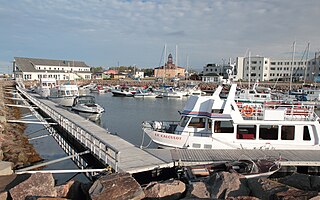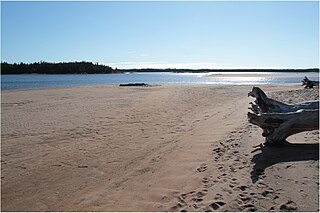
Canada has a vast geography that occupies much of the continent of North America, sharing a land border with the contiguous United States to the south and the U.S. state of Alaska to the northwest. Canada stretches from the Atlantic Ocean in the east to the Pacific Ocean in the west; to the north lies the Arctic Ocean. Greenland is to the northeast with a shared border on Hans Island. To the southeast Canada shares a maritime boundary with France's overseas collectivity of Saint Pierre and Miquelon, the last vestige of New France. By total area, Canada is the second-largest country in the world, after Russia. By land area alone, however, Canada ranks fourth, the difference being due to it having the world's largest proportion of fresh water lakes. Of Canada's thirteen provinces and territories, only two are landlocked while the other eleven all directly border one of three oceans.

The Gulf of St. Lawrence is the outlet of the North American Great Lakes via the St. Lawrence River into the Atlantic Ocean. The gulf is a semi-enclosed sea, covering an area of about 226,000 square kilometres (87,000 sq mi) and containing about 34,500 cubic kilometres (8,300 cu mi) of water, at an average depth of 152 metres (500 ft).

Anticosti Island is an island in the Minganie Regional County Municipality, in administrative region of Côte-Nord, the province of Quebec, Canada.
The Jacques Cartier Strait is a strait in eastern Quebec, Canada, flowing between Anticosti Island and the Labrador Peninsula. It is one of the two outlets of the Saint Lawrence River into its estuary, the Gulf of Saint Lawrence. The other is the Honguedo Strait on the south side of Anticosti Island.

Located in the eastern part of Canada, and part of Central Canada, Quebec occupies a territory nearly three times the size of France or Texas. It is much closer to the size of Alaska. As is the case with Alaska, most of the land in Quebec is very sparsely populated. Its topography is very different from one region to another due to the varying composition of the ground, the climate, and the proximity to water. The Great Lakes–St. Lawrence Lowlands and the Appalachians are the two main topographic regions in southern Quebec, while the Canadian Shield occupies most of central and northern Quebec.

Minganie is a regional county municipality in the Côte-Nord region of Quebec, Canada. It includes Anticosti Island. Its seat is Havre-Saint-Pierre.

Côte-Nord is the second-largest administrative region by land area in Quebec, Canada, after Nord-du-Québec. It covers much of the northern shore of the Saint Lawrence River estuary and the Gulf of Saint Lawrence past Tadoussac.

The Mingan Archipelago National Park Reserve is a national park reserve located in the eastern area of Quebec, Canada, on the north shore of Gulf of St. Lawrence. It features the Mingan Archipelago, a chain of around 40 islands.

Havre-Saint-Pierre is a town on Pointe-aux-Esquimaux, which is on the Quebec north shore (Côte-Nord) of the Saint Lawrence River in Canada. Located along Route 138 some 200 kilometres (120 mi) east of Sept-Îles, it is the largest town and seat of the Minganie RCM, and home to many government, municipal, and regional services.
Grand-Lac-Salé Ecological Reserve is an ecological reserve of Quebec, Canada. It was established on January 24, 1996. It is located on the south shore of Anticosti Island.

The Eastern Canadian forests is a taiga ecoregion in Eastern Canada, as defined by the World Wildlife Fund (WWF) categorization system.

The Romaine River is a river in the Côte-Nord region of the Canadian province of Quebec. It is 496 kilometres (308 mi) long. It is not to be confused with the Olomane River that is 220 kilometres (140 mi) to the east and had the same name for a long time. It flows south into the Gulf of Saint Lawrence.

The Nuyts Archipelago is an island group located in South Australia in the Great Australian Bight to the south of the town of Ceduna on the west coast of the Eyre Peninsula. It consisting of mostly granitic islands and reefs that provide breeding sites for Australian sea lions and support colonies of short-tailed shearwater. It also includes the island group known as the Isles of St Francis. All the islands with exception of a part of Evans Island, are located within the following protected areas: the Nuyts Archipelago Wilderness Protection Area and the Nuyts Archipelago Conservation Park.

Roland-Benoît Jomphe (1917–2003) was a Quebec poet from the Minganie region of Quebec.

The Corneille River is a river in the Côte-Nord region of Quebec, Canada. It empties into the Gulf of Saint Lawrence opposite Anticosti Island.
The Ours River is a tributary of Gulf of Saint Lawrence, flowing in the municipality of Havre-Saint-Pierre, in the Minganie Regional County Municipality, in the administrative region of Côte-Nord, in the Province of Quebec, Canada.

Mingan River is a 117-kilometre (73 mi) salmon river of the Côte-Nord region of Quebec. It flows from north to south and empties into the Gulf of Saint Lawrence.

The Chicotte River is a tributary of the Gulf of Saint Lawrence, flowing in the municipality of L'Île-d'Anticosti, in the Minganie Regional County Municipality, in the administrative region of North Shore, in province of Quebec, in Canada.

The Île-aux-Perroquets lighthouse is a lighthouse on the Île aux Perroquets in the Mingan Archipelago, Gulf of St. Lawrence, Quebec, Canada. It was built in 1951, replacing an 1888 wooden lighthouse. It received heritage designation in 2014.
















